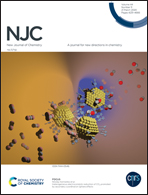Effects of different plasticizers on highly crosslinked NaAlg/PSSAMA membranes for pervaporative dehydration of tert-butanol
Abstract
Polystyrene sulfonic acid-co-maleic acid (PSSAMA) crosslinked sodium alginate (NaAlg) membranes were developed by incorporating diethyl phthalate (DEP), dibutyl phthalate (DBP) and dioctyl phthalate (DOP). The physico-chemical properties of the resulting membranes were studied using FTIR, WXRD, TGA, DSC, AFM and SEM techniques. Before the membranes were subjected to pervaporation studies, the membranes’ sorption studies were carried out in different compositions of water/tert-butanol. The effects of the different plasticizers on their pervaporation performance were investigated systematically for the separation of water/tert-butanol mixtures at different temperatures. Among the membranes, the membrane containing DEP exhibited the highest separation factor of 12 830 with a flux of 1.306 × 10−3 kg m−2 h−1 for 10 mass% water in the feed. The total flux and the flux of water were found to overlap with each other, indicating that the developed DEP incorporated membrane could be used effectively to break the azeotropic point of water/tert-butanol. The activation energy obtained for the permeation of water (Epw) was significantly lower than that of tert-butanol (EpTER), suggesting that the DEP incorporated NaAlg/PSSAMA membrane had a higher separation ability and thus demonstrated excellent performance in the dehydration of tert-butanol. The heat of sorption (ΔHs) of all the membranes was found to be negative, indicating that Langmuir's mode of sorption is predominant.



 Please wait while we load your content...
Please wait while we load your content...